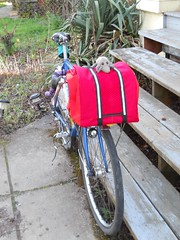Mar 30, 2012

Weighty deliberations.
—orc Fri Mar 30 21:25:56 2012
Mar 24, 2012

I took the project bike out to ride Sellwood-Birkenfeld-Sellwood today and discovered that though the first 90 miles of the loop was excellent, the last 60 miles became progressively less so.
It’s a pretty heavy bike, and 48/38 chainwheels combined with an 11-26 cassette leaves me with not very much in the department of climbing gears. Which was less than desirable on the last big climb (Old Cornelius Pass Road+Skyline Blvd) of the day, and was completely undesirable on the little steep ramp up to Vaughn St.
I should probably put a more conventional compact double on the thing, even if that means I have to sacrifice the biopace chainwheels in favor of boring old circular ones :-(
Other things that didn’t work:
- The rear wheel is not completely dished, and when combined with a rear fender that doesn’t have much clearance it resulted in a intermittent rub after I bounced the bicycle over one of the bridges on the Banks-Vernonia linear trail.
- The roll-top porteur bag, as expected, isn’t the greatest thing to use for a rando bag (because you can’t just open it up and fish around at speed) but it does have the advantage that I can carry a lot of stuff along.
- I need to repack the MKS AR-2 pedals, because they got too much bearing grease washed out when fording streams on Cedar Canyon Road last week.
Things that did work:
- This bicycle has the xtracycle nature in that if it’s pointed down a steep ramp it accelerates as if it was dropped out of an airplane. It made the descent down Germantown Road very interesting, particularly when I reached the hairpin curves near the bottom of the hill.
- Rubber-banding the gps to the handlebars works well over a longish brevet.
- The compact drops make it very easy to spend 10s of miles living in the drops.
—orc Sat Mar 24 23:58:28 2012
Mar 23, 2012
Mar 21, 2012

After making a roll-top porteur bag for a friend, I decided that I wanted to make one up for myself (I’d taken my porteur-randonneur bag out for a 80 mile loop a few weeks ago and had it get fairly saggy; I took it out for a 90 mile loop this past weekend and had to wedge a piece of coroplast under it to keep it from sagging), so I sat down this morning and cranked this one out (in about 4 hours exclusive of making a lining and sewing it into the bag) so I can try it on the 230km loop I’m going to do with a few friends this upcoming weekend.
This one has one external mesh pocket in the front, and is assembled more like my big rando bags (a single front-bottom-back piece with separate side panels.) It’s actually two different sensor-frying shades of red, but you can’t actually see the difference because the camera sensor can’t resolve them as anything other than RED!!!
It’s not the most efficient thing for randonerding (no mapcase, no side pocket to put my camera into) but it’s certainly worth trying. And it will certainly work better than a rando bag for grocery shopping (300mm × 300mm × 450mm – almost big enough to fit two big rando bags into!)
—orc Wed Mar 21 20:39:20 2012
Mar 20, 2012
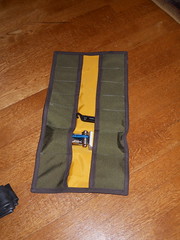
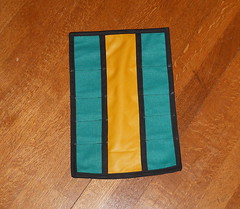
I’d put my handmade saddlebag (and Carradice bagman duplicate rack) I’d made a couple of years ago onto the project bike so I could have something to carry a multitool, patch kit, and a spare tube in, but that bag is much too big for just those few items. And today I was close enough to the surface to want to practice taping edges & seams before starting the next three handlebar bag projects (plus another roll-top porteur bag for the project bike.)
What’s a nice simple project that needs to be taped, and that won’t eat up many hours before I get to the point of sewing the tape on? Tool rolls; ~16×16 squares of cordura for the outside, a ~16×10 rectangle of yellow fabric for a liner, and a couple of yards of tape.
About half an hour each, and neither of them is so appalling that I wanted to throw them out when I was finished! (I made the somber green one first, but the huge tubes for the project bike were a very tight fit into the tube pocket, so I dragged out a chunk of bright green to make one with a larger tube pocket to replace it.)
—orc Tue Mar 20 22:57:13 2012
Mar 19, 2012
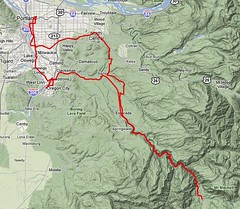
This is the other of my flat permanents; there’s about 4000 feet of climbing here, but there are only two long steep ramps in the entire loop.
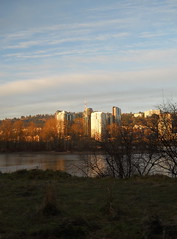
The loop starts in NE Portland (originally at the Kettleman’s Bagels on Broadway, but Kettlemans got et by Noahs, so now it’s an open start/finish) and, after a couple of miles of wandering through city streets, deposits you onto the Springwater Trail for a 20 mile run out to the end of the line in Boring (the paved part of the trail ends 2 ½ mile short of Boring, so the cuesheet directs you onto the adjacent county road, but if you stay on the gravelled railroad ROW you’ll be deposited in Boring right across the street from the road south.)

The road south of Boring rolls for a while through berry orchards and exurban developments, then plunges down off the edge of the Boring Lava down to the Clackamas River Valley. And then, to pay for the descent, you climb back up to the top of the bluff and roll along quiet country roads until you reach the edge of civilization in Estacada.

Once you leave Estacada, there are no services until Ripplebrook except for a minimart at the Promontory Point campground 7 miles up the line, and that minimart is not open during the offseason. If you’re feeling like you need a little something, this is a good place to stop, because after you hop onto OR 224 and head into the gorge (with a brief detour onto PG&E’s Faraday Road to get around a horrific hillclimb on 224) there’s nothing there except the gorgeous scenery as you and the Clackamas River wind up into the mountains.
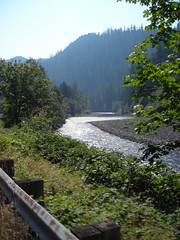
You’re climbing here, but for the most part it’s not noticable because you’re riding alongside the river, only occasionally going up a short ramp and then waiting for the river to catch up. And then you cross a couple of bridges, then two more, and then you go up 600 feet or so to reach the ledge that Ripplebrook sits on.
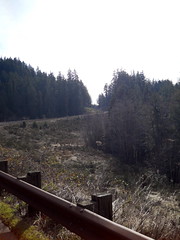
And at the top of the ramp it’s just a couple of miles until you reach the end of the line at the Ripplebrook Ranger Station, where you can stop for a little something and a receipt before turning around and heading back the other way.
It may have seemed like a long time to get down to Ripplebrook, but that’s because of the invisible grades. Going back can be considerably faster; if you were battling strong headwinds going towards Ripplebrook, those winds will blow you back down the gorge faster than you can say Jack Robinson, but even if they aren’t blowing you’ll find yourself at Faraday Road, then Estacada, almost before you can blink.
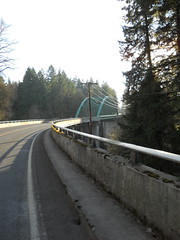
If you know the area, you can detour off OR 224 here and follow Eagle Creek Road north for a while before being forced back onto the highway, but in any case you need to follow the highway north until you reach Barton, because that’s where you jump across the Clackamas River to ride backroads (Baker’s Ferry Road, then Springwater Road, then Clackamas River Road) all the way into Oregon City, where you loop through downtown before heading back north into Portland.
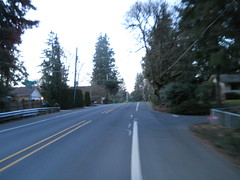
You’re in the city for the rest of the ride now (12 miles, more or less) but most of the roads going back towards Portland are very wide and have generous bike lanes, so it’s generally not the sort of urban riding experience you might expect.
And when you reach the end of the line, you’re back in one of Portland’s business districts, so there are many coffeehouses and pubs where you can get cards signed and have a little something before heading home.
A cuesheet is available here, and if you want to ride this for RUSA credit contact me at orc@pell.portland.or.us.
—orc Mon Mar 19 23:53:06 2012
Mar 17, 2012
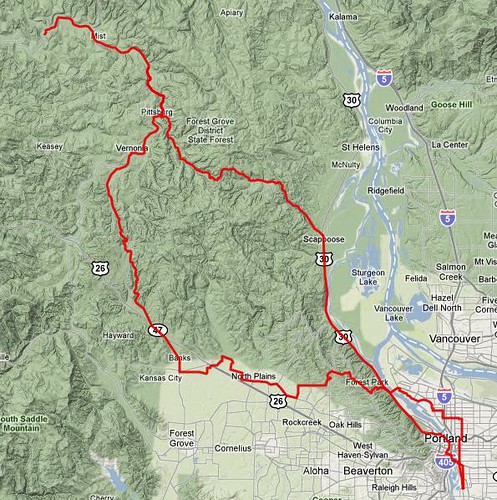
I have a smallish stack of Portland based permanents, most of which involve stupid amounts of climbing. This is not one of them. It starts at somewhere around the corner of Milwaukie & Bybee (the exact location is unsure, because the opening/closing controls are open, but the Marsee Baking just west of Milwaukie is a good place to start, and the Staccato Gelato just west of that is a good place to finish) and proceeds up into NE Portland, across the St. John’s bridge, and up highway 30 to Scappoose, where you cut west up and over the Nehalem divide, then north along the Nehalem River to the tiny logging town of Birkenfeld.

The route back to Portland is slightly different; instead of recrossing the Nehalem divide at Pittsburg, the route proceeds southwest to Vernonia, where it diverges onto the Banks-Vernonia linear park for the 20-odd miles into Banks.
This is an old railroad ROW, so it’s moderately graded (except for a gap just north of the summit where a long bridge burned; the replacement path plunges down the hill to cross highway 47, then ascends just as steeply up the other side of the valley to rejoin the railroad ROW for the rest of the trip down to Banks) and an easy climb and even easier descent.
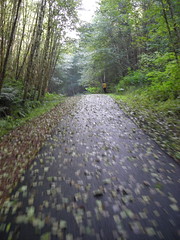
One game I like to play when I’m riding this route is to just stop pedalling at the top of the grade and to see how far I can coast before I have to pedal. There are a couple of grade crossings, a pair of extremely rough bridge approaches, and a gravel road crossing at almost the bottom of the grade, which make this a bit of a challenge, but it’s a fun way to burn off 8-9 miles of the loop.
And then you’re at Banks, where you go back onto the public roads for the last 30 or so miles into town. There’s one last climb on Old Cornelius Pass Road (the Rock Creek Tavern sits right across from where the route deposits you onto Old Cornelius Pass Road, so this is a good place to stop for a snack if the idea of another 1000 feet of climbing is daunting) and a correspondingly terrifying descent on Germantown Road before you get back into Portland for the last 10 miles of riding back to the end of the line in Sellwood (An acceptable reroute is to take Skyline further south to Saltzman Road, which is a gravel pedestrian/bicycle route in Forest Park that deposits you on St. Helen’s Road a mile or so south of where Germantown Road would drop. I have gone down Saltzman Road in the dark on 25mm tires, so it’s not exactly what you’d call a technical descent.)
A cuesheet is available here, and if you want to ride this for RUSA credit contact me at orc@pell.portland.or.us.
—orc Sat Mar 17 20:55:11 2012
Mar 16, 2012
Mar 15, 2012
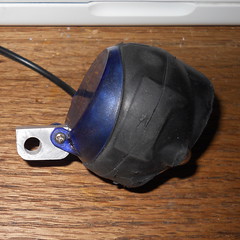
The project bike doesn’t have a headlight yet (aside from a not-wired halogen headlamp which needs a wired taillight to keep from exploding) so I modified an old headband lamp to fit onto the m5 bolt I’ve got on my porteur rack.
A little piece of aluminum cut from a square stick, drilled for a m5 bolt and a tiny self-tapping screw, then filed to snuggle up next to the lamp, and finally sanded to remove (some of) the file marks.
I need to get a proper headlight/taillight combo, but this will do for this weekend’s populaire.
—orc Thu Mar 15 22:51:49 2012
Mar 13, 2012
Mar 11, 2012
A couple of years ago, I was given a broken (the case was broken, but not the electronics) B&M Ixon bicycle light, which I promptly tested, then stripped off the case and set aside for future putting into a light. Today, I decided that it would be a good time to solder it into a test harness and see if it would work. So I soldered a couple of wires to the + and - pads of the battery mounting points, attached a string of 4 AA batteries, then pushed the button to turn it on.
I immediately got a gratifyingly bright light, but, alas, this light was not from the LED, but from the circuit board, and it came along with a cloud of foul-smelling smoke. And, equally sadly, this only happened once; subsequent applications of voltage resulted in nothing but the circuit lying there sulking.
I tested the LED proper (by attaching it to a slightly-overdriven 3.7V cellphone battery) and got a whole bucketload of light (it took about 5 minutes for the receptors in my eye to recover from the overload) which I could repeat at will (but not for very long, because these 1 watt LEDs generate a lot of heat, and I didn’t have a headsink attached.) So, yay, I’ve still got a power LED. It’s not really usable yet, so it’s still a whoops.
In the worst case I can build a circuit that’s just the LED wired to a cellphone battery and a switch; it won’t be nearly as nice as one that gets power from a dynamo, but it would be better than nothing.
—orc Sun Mar 11 03:11:35 2012
Mar 09, 2012
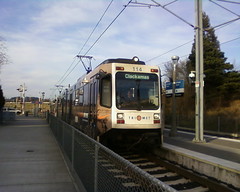
I was heading north and the train was heading south, so I had to stop and take a picture.
—orc Fri Mar 9 23:52:50 2012

Dust Mite helps me sort out my desk.
—orc Fri Mar 9 22:31:43 2012
Mar 04, 2012
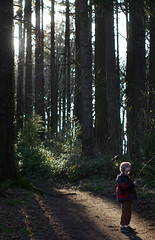
Silas strikes a contemplative pose in Hoyt Arboretum.
—orc Sun Mar 4 23:21:23 2012
Mar 03, 2012
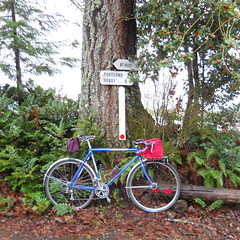
I took the project bike up Marmot Road today to see how it would feel when riding a longer (~110k) and steeper loop than my regular perambulations around Portland. It worked out quite well(and, as is traditional, the biopace chainrings made climbing easier than it usually is; I did the entire loop using the 48t chainring, only dropping down to 48:26 on a couple of fairly steep sections) and aside from a few minor quibbles (the narrower saddle on the bike is made of very stout leather, so it’s not as comfortable out of the box as the saddles on the MLCM and Trek are; the lack of mudflaps does not work well when I’m running through mud and gravel; and the fork crown bolt worked its way loose, which meant the porteur rack flexedplaned even more than it normally does for about 70% of the loop) it looks as if I’ll be able to test it out on the next 200 I ride (maybe next weekend?)
And then when I came home I had to go out shopping on the Trek, and discovered to my intense dismay that the formerly just right feel of the xtracycle now feels like its too small. Sigh. The first casualty of the project bike may be my seat adjustment on the other machines.
—orc Sat Mar 3 23:41:17 2012
Mar 02, 2012

Dust Mite holds down my porteur-randonneur bag.
—orc Fri Mar 2 21:32:59 2012
—30—


